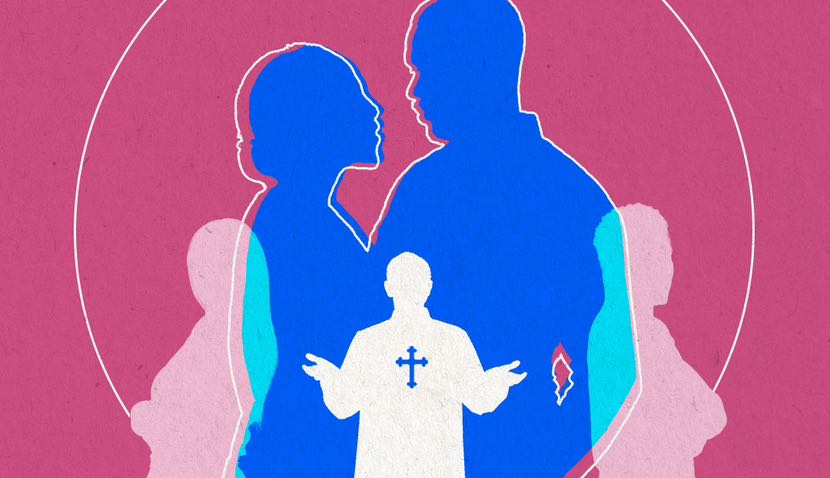Research Question
Intimate partner violence (IPV) and religious salience are two variables that seemingly correlate in numbers. However, these two groups have a third variable in common: traditional values, which may reveal violence in the home when said values are misused. In looking at religious people’s level of agreement with statements related to IPV, there is hope in identifying and spreading awareness of the IPV rates in religious communities and providing aid to victims.
Literature Review

Religious beliefs bear a great deal of influence on human lives, as they help to shape our values and affect our relationships with others. Émile Durkheim conceptualized that religious groups encourage community morality and emphasize social cohesion (Gezinski et al., 2023). While religion has its positive attributes in society, it has also been related to intimate partner violence (IPV). While men and women can commit the act of IPV, men are responsible for 92% of the reported cases of IPV compared to women (Levitt et al., 2008). In addition to this statistic, there appear to be greater repercussions in the act of IPV against women. IPV makes up 21% of female violent crimes and 30% of the causes of female murder (Levitt et al., 2008). Women often experience significant physical, financial, and emotional injuries experienced at the hands of male partners (Levitt et al., 2008). IPV is undoubtedly a major issue in society, and understanding the role that religion plays in the cases of IPV perpetuated by men is crucial for developing effective support and prevention systems.
Religion has historically been used as a tool in enforcing subservient women. While conservative Christians are the group most frequently associated with patriarchal views, men do not have a higher abuse rate compared to other men (Levitt et al., 2008). The possibility of a correlation between religious salience and IPV derives from the perpetrators’ lack of understanding surrounding their authority over their wives. In a survey of 2,500 currently abused women, data revealed that 24% of their perpetrators used religion as justification for their violence (Levitt et al., 2008). In addition to the effects on the perpetrators, religion was also the motive for the victims to stay in their abusive relationships (Levitt et al., 2008). This leads to the desensitization of IPV in the family.
Moreover, it perpetuates the cycle of violence and lends the possibility of higher victimization rates in their children. While the Christian church has programs for preventing IPV, Todhunter and Deaton’s (2010) research found that they often appeal heavily to the religious and spiritual motivations of the individuals. While the classes address IPV, less time should be spent on teaching spirituality to include lessons on the dangers of social conformity (Todhunter & Deaton, 2010).
Furthermore, this is limiting in their reach to the youth, as research has found that a combination of both secular and religious resources may prove to be more fruitful in their approach to the prevention of IPV (Todhunter & Deaton, 2010). The need for IPV-informed Christian leaders is also greatly lacking. Religious leaders lack the training that service providers are required to be versed in, and, despite this, victims will seek assistance from their religious leader rather than approach law enforcement or a domestic violence services organization (Gezinski et al., 2023). Additionally, religious leaders may be guilty of supporting IPV relationships. One Catholic priest asked a victim, “What did you do to make them [the perpetrator] mad?” while an LDS bishop instructed one victim to go back to her abusive relationship “because he is a good man and you need to make your marriage work” (Gezinski et al., 2023, p. 2509). This act of diminishing the impact of IPV further isolates the victims and continues the cycle of IPV within the Christian community.
Hypotheses
H0: There is no relationship between religiousness and intimate partner violence.
H1: There is a significant relationship between religiousness and intimate partner violence.
Methods
Data
The experimental data come from the Crime, Health, and Intimate Partner Problems Survey (CHIPPS), a cross-sectional probability sample of St. Mary’s University undergraduate students (n = 200) designed to analyze differences in partner violence and religion. Students were randomly chosen via their student email. The survey was then disseminated via email so that participants could complete it on their computer or mobile device. Respondents were offered a $10 gift card to participate in the survey. Data was collected between Spring and Fall of 2024.
Measures
- Partner Violence. To explore initial attitudes toward partner violence, respondents were asked if “it is okay to hit your partner?” Answer options ranged from “Strongly disagree” = 0 to “Strongly agree” = 3. The variable was then dummy coded so that “Strongly disagree/disagree” = 0 and “Strongly agree/agree” = 1.
- Religious Salience. To gauge how religious respondents felt, an ordinal question asking about religiousness was used. This question asked, “How religious are you?” Respondents could choose “Not religious” = 0, “Slightly religious” = 1, “Moderately religious” = 2, and “Very religious” = 3.
- Feelings about Current Relationship. Respondents were asked to gauge their “level of happiness toward their current relationship.” Responses consisted of “Very unhappy” = 0, “Unhappy” = 1, “Happy” = 2, and “Very happy” = 3.
- Respondent’s Age. Age (in years) was recorded by asking respondents, “How old are you?”. Respondents answered anywhere from 18 to 22 years of age.
- Gender. Gender was coded by asking respondents to indicate their gender. Initial responses included “Male” = 1, “Female” = 2, “Transgender” = 3, and “Other” = 4. Due to few responses in the “Transgender” and “Other” categories, this variable was dichotomized so that “Male” = 0 and “Female” = 1.
- Race/Ethnicity. To ascertain the respondent’s race/ethnicity, they were asked, “With which group do you most closely identify?” Response categories ranged from “Non-Hispanic White” = 1, “Hispanic” = 2, “African American” = 3, “Asian” = 4, and “Other” = 5. The variable was then recoded into a series of four dummy variables with “Non-Hispanic White” as the reference group (e.g., Hispanic/African American/Asian/Other = 1, Else = 0).
- Household Income. To gauge the total income in respondents’ households, they were asked to “select the category that gives the best estimate of your total annual household income (income of all family living in your home) before taxes in the last year (not including scholarships or grants).” Possible responses ranged from “None/Under $5,000” = 0 to “$75,000 or more” = 10.
- Class. Respondents were asked to identify their current student classification. This classification follows the Office of the Registrar’s method, which bases classification on the total amount of hours (including those currently enrolled by the student) when determining their classification. These options included “Freshman” = 0, “Sophomore” = 1, “Junior” = 2, “Senior” = 3.
- Employment Status. Lastly, respondents were asked to identify their current employment status. Responses included “Other” = 0, “Unemployed” = 1, “Part-time” = 2, “Full-time” = 3.
Results

Table 1 displays a bivariate analysis of the sample’s religiousness, based on whether they agree or disagree that hitting a partner is okay. The chi-square test (p ≤ .69) indicates that there is not a significant relationship between religiousness and attitudes toward IPV. As such, I fail to reject the null hypothesis. Table 2 further supports this finding and provides exploratory analyses of whether any sociodemographic variables might be statistically significant with IPV. The findings show that there are no significant findings.

Conclusion
This study explored the inconsistencies in the association between religion and IPV (Levitt et al., 2008; Toddhunter & Deaton, 2010). The present study’s null findings contribute to the literature’s complex understanding of how religion may influence IPV. As such, it seems that college students at a private university do not have to contend with IPV with respect to how religious they are, let alone other personal characteristics. It may be that extraneous traditional values play a larger role in the individual’s religiousness, and as such, it would behoove future researchers to examine different socioeconomic and cultural factors when examining IPV.
References
Gezinski, L. B., Gonzalez-Pons, K. M., & Rogers, M. M. (2023). “Praying does not stop his fist from hitting my face”: Religion and intimate partner violence from the perspective of survivors and service providers. Journal of Family Issues, 44(9), 2504-2524.
Levitt, H. M., Swanger, R. T., & Butler, J. B. (2008). Male perpetrators’ perspectives on intimate partner violence, religion, and masculinity. Sex Roles, 58, 435-448.
Todhunter, R. G., & Deaton, J. (2010). The relationship between religious and spiritual factors and the perpetration of intimate personal violence. Journal of Family Violence, 25, 745-753.



9 comments
Mariana Chamorro
Carina, your publication on intimate partner violence and religious salience is informative and well-researched. I appreciate how you’ve explored the complex relationship between these variables and provided valuable insights into the role of traditional values. Overall, your work contributes to a deeper understanding of IPV within religious communities. Well done!
Rhys Williams
I found your exploration of the intersection between religion and intimate partner violence (IPV) both enlightening and thought-provoking. The quote from Émile Durkheim, which highlights the role of religious groups in promoting community morality and social cohesion, adds depth to the discussion surrounding the influence of religious beliefs on human behavior. Understanding the correlation between religion and IPV, particularly the disproportionate impact on women, is crucial for developing effective support and prevention systems in society.
Stela Naomi Sifuentes
Wow, what a study Carina! It’s interesting to see the independent and dependent variables at play. How intricate they are and how much of an impact religion plays on relationships negatively for some couples.
Sebastian Hernandez-Soihit
Very interesting study, a good follow up would be to do case studies in select areas and zip codes of the US with different levels of religiosity and perhaps even cross it with some variables like income or political affiliation. Amzingly done!
valeria garza
Carina!!! This research paper is so awesome, I love it. 😀
lvaldez12
Hi Carina this article was very well written and proved us with very vital information that many wouldn’t have even thought of. I for one never really though about how religion can make such a big impact on IPV an how such harmful beliefs can make a bigger impact on relationships that may be already experiencing IPV. The way we saw the study take place and were able to see the results was well thought out as well because it show us even more just how no matter if you are a man or women you can be deeply affect by IPV.
Jonathan Flores
This article expertly navigates a serious and important topic in our social lives with a very professional writing style. First, I found this article particularly interesting because when we think of domestic violence, we often overlook the possibility of religion playing a role. Moreover, you displayed how religion can be one of the most influential factors when examining IPV. This was very well done and I appreciate you bringing an important topic to light. Good job.
Vianna Villarreal
Such an interesting way to study religion and marriage. Religion plays a huge role in human life, it is basically a path for people in the way they decide to live life. That is a powerful way to see how different religions differ from others and how their beliefs can become problematic in society. Like in numerous religions where there is misunderstanding about a woman’s role. I think this plays a large part in why so many men are the oppressors when it comes to intimate partner violence. Great way to research a topic very interesting.
Elizabeth Gonzalez
Good evening Carina, I loved this article. This was very informative, and I had not thought about the possible effects that religion has on intimate partner violence. I can certainly say that religious groups can engage in critical thought and discourse to question the harmful ideas and interpretations that contribute to IPV. Emphasizing ideals like as equality, mutual respect, and nonviolence can assist in fostering a culture of accountability and support in religious groups. Religion salience has a complicated and diverse impact on IPV, impacted by a wide range of factors such as religious teachings, cultural norms, and community dynamics. Religious groups may help to prevent and address IPV by promoting principles such as respect, equality, and nonviolence, as well as helping survivors find safety and recovery.